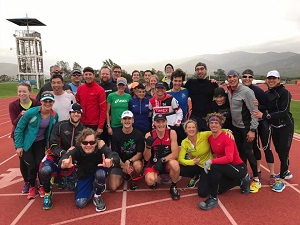Triathletes Get Elite-Level Training at No Sight No Limits Camp

The inaugural No Sight No Limits USA Blind Triathlete High Performance Camp took place January 21-25 at the Chula Vista Elite Athlete Training Center in California. Led by former Team USA Paratriathlete, Amy Dixon (Greenwich, Conn.), the camp offered athletes the opportunity to reach a new level of training by providing hands-on instruction and information sessions on nutrition, recovery and mental strategies specific to athletes with visual impairments and hearing loss.
“I was inspired to start this camp after meeting so many blind athletes from around the world racing towards the Paralympic Games this past season,” said Dixon.
Fifteen athletes ranging in age from 22 to 64 years old, from across the country, attended No Sight No Limits. David Kuhn (Dekalb, Ill.), who competed in the 2016 USABA Marathon National Championships in December, attended the camp to push his limits.
“Amy’s camp taught us advanced skills,” said Kuhn. “This was not a camp for beginners.”
Unable to pinpoint his biggest takeaway, Kuhn listed one takeaway from each discipline. In the pool, Kuhn described learning to draft off of someone. “It was interesting how I was able to feel the churning of the water behind my guide’s feet. Then, how easy it was for me to tell when the water was not churning, indicating that I had drifted too far behind him and was no longer drafting.”
On the bike, Kuhn and his pilot, Rick van Tuyl (San Clemente, Calif.), practiced close, tight turns at slow speeds. “The pilots had to maintain control at very slow speeds while we, the stokers, had to remain focused and perfectly balanced. We ended up in the mud on the side of the road a couple of times,” Kuhn joked.
The technical takeaway Kuhn might have been most excited about was in running. “I now have drills to improve my running pace. When executed properly, the drills work very quickly in improving running form and pace. Repeated use of these drills will help me build a faster pace and develop endurance at that pace.”
In addition to the hands-on training and instruction participants received from USA Triathlon-certified coaches, the group was coached on things they can do mentally to enhance their training. The session Kuhn found most impactful was Dixon’s talk on working with guides.
“Amy shared with us her experiences with guides and how it’s imperative that you hold each other accountable,” said Kuhn. “Sometimes you have to crack the whip and get your guide focused, sometimes they need to get your focused. [Amy] did a really great job of describing the guide/athlete relationship and how it must be a team mentality.”
Alison Lynch (New York, N.Y.), who ran as part of a relay team with USABA at the California International Marathon in December, chose to attend No Sight No Limits to become more confident in open-water swims and to work on her transitions.
“I’m not a strong swimmer,” said Lynch, “especially outside in bright light when I lose what usable vision I have.”
Having learned to swim just seven months before the camp, pool drills were the biggest challenge she overcame at No Sight No Limits. “After three days of swimming in what would be my least favorite conditions, I felt much more confident in how I need to keep training to prepare for that kind of condition in a race.”
The transition clinics also helped Lynch’s confidence. “I’m testing out new gear so I need to feel comfortable getting it on and off as fast as possible!”
Off the course, participants benefited from classroom sessions on nutrition, recovery and mental strategies. Lynch cited the nutrition session as particularly impactful. “Fueling your body is so critical, and feeling well will only improve your race.”
The icing on the cake for No Sight No Limits participants was the networking that happened and the bonds that were formed over four days of intense training.
“What has become very important to me is repeated encounters with my blind and visually impaired athletic friends and our guides,” said Kuhn. “To see old friends and make new ones is another big takeaway, whose importance cannot be overrated.”
“The networking with other athletes, guides and coaches was invaluable,” said Lynch. “Even though we each have our own challenges, both visually and based on our own strengths, it’s incredibly beneficial to bound ideas off everyone, to get feedback and to compare strategies.”
No Sight No Limits was made possible through private donations and volunteer coaches and staff. If you are interested in supporting the next camp as a volunteer or donor, or participating as an athlete, email Amy Dixon at Amy@AmyDixonUSA.com.
